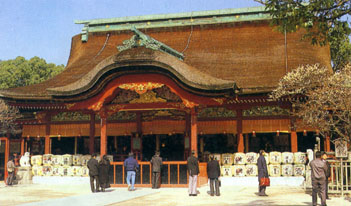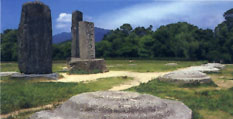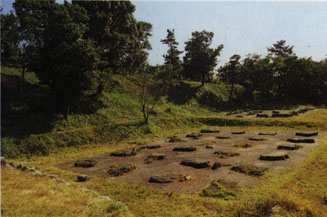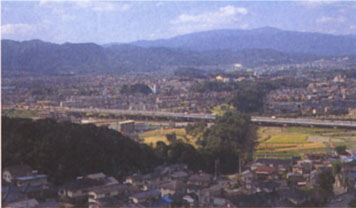
1 Dazaifu Tenmangu Shrine
Dazaifu Tenmangu Shrine is sacred to the memory of Michizane Sugawara
, also as "the god of learning." In 901 A.D., Michizane
was suddenly demoted from his position as Minister of the Right
and send to work at the Dazaifu, where he died two year later.
Dazaifu Tenmangu Shrine was build on the site of his grave. The
main hall, as it stands today, was constructed in 1591 A.D. and
is registered as an Important Cultural Property. Within the Shrine
precincts are many plum trees, camphor trees, and irises, which
provide natural beauty in every season of the year. Tenmangu's
history is recalled by the event such as the New Year's Festival
( Oni-sube), the Spring Water Poetry Festival (kyokusui-no-en),
and the Annual God-Procession (Jinko-shiki) which takes place
in the Fall.

...
3 Site of Dazaifu Government Office (National
Historical Site)
The site of Dazaifu government office is known a "Tofuro."
During the Nara and Heian periods the Dazaifu was responsible
for super vising Japan's maritime frontier and for administering
the nine provinces and two island of the Saikaidou (modern Kyushu).
In those days, a great edifice with vermilion-lacquered columns
and a tiled roof stood at the foot of Mutton, but today all that
remains is a park containing the huge foundation stones of the
original building.

4 Ruins Ono Fortress (National Historical Site)
The north of Dazaifu City, there is a mountain called Mt.Shioji.
Ono Fortress was build on its summit in 665 A.D. for the protected
Dazaifu. It consisted of a number of buildings surrounded by a
mud and stone embankment which was 8 kilometers in curcumference.
All that remains today is part of the embankment and the foundation
stones of about 70 storehouses. Mt.Shioji was originally called
Mutton, a name which often appears in Manyo poetry. The name Mt.Shioji
comes from the Shitenno (Four Deva kings) which were enshrined
on the mountain.

...
...
6 Ruins of Mizuki (National Historical Site)
In the Northwest of the city there is a long, low embankment cutting
directly across the plain. This is Mizuki or "Water Fortress,"
which was build in 664 A.D. to defend the Dazaifu China and/or
Korean kingdom of Silla. Altogether, the Mizuki is 1.2 kilometers
long, 80 meters wide, and 10 meters high. The name "Water
Fortress" comes from a moat which used to exist on the Hakata
side. According to archaeological investigations the moat was
60 meters wide and 4 meters deep. Smaller embankments of the same
type as the Mizuki are found i Kasuga City and O-nojo City.

(Dazaifu Historical Guides)
Back to Home
Page
We want several opinions for it, please send
E-mail to Yukio Yokota.
E-mail sinkodai@os.xaxon.ne.jp
Created & Maintaince by" Yukio Yokota"